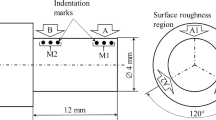Abstract
Any shortfall in the required depth during milling machining can affect the dimensional accuracy of the part produced and can cause a catastrophic failure to the machine. Corrective remedies to fix the dimensions inaccuracy will increase the machining time and costs. In this work, a depth-of-cut monitoring system was proposed to detect depth of cut in real time using an acoustic emission sensor and prediction model. The characteristics of the sensor signal obtained in machining processes can be complex in terms of both nonlinearity and nonstationarity. To overcome this complexity, a regression model and an artificial neural network model were used to represent the relationship between the acoustic emission signal and the depth of cut. The model was tested under different machining cases and found to be efficient in predicting the depth of cut.
Similar content being viewed by others
References
Duro AJ, Padget JA, Bowen CR, Alicia Kim H, Aydin N (2016) Multi-sensor data fusion framework for CNC machining monitoring. Mechanical Systems and Signal Processing 66–67:505–520
Newman S, Nassehi A, Imani-Asrai R, Dhokia V (2012) Energy efficient process planning for CNC machining. CIRP J Manuf Sci Technol 5(2):127–136
Choi JG, Yang MY (1999) In-process prediction of cutting depths in end milling. Int J Mach Tools Manuf 39([Inspec] [ISI]):705–721
Yang L, DeVor R, Kapoor S (2005) Analysis of force shape characteristics and detection of depth-of-cut variations in end milling. J Manuf Sci Eng 127:454. doi:10.1115/1.1947207
Wan M, Zhang WH (2006) Efficient algorithms for calculations of static form errors in peripheral milling. J Mater Process Technol 171:156–165
Li H, Shin YC (2006) A time-domain dynamic model for chatter prediction of cylindrical plunge grinding processes. ASME J Manuf Sci Eng. (in press).
Kang Y, Wang Z, Wu J, Jiang C (2006) Numerical prediction of static form errors in the end milling of thin-walled workpiece. IET Conf Pub. 816, doi: 10.1049/cp:20060872.
Prickett P, Siddiqui R, Grosvenor R (2010) The development of an end-milling process depth of cut monitoring system. Int J Adv Manuf Tech. doi: 10.1007/s00170-010-2711-6.
ASTM Standard E610–82 (1982) Standard definitions of terms relating to acoustic emission. American Society for the Testing Materials, West Conshohocken, PA
Kaiser J (1950) Untersuchungen uber das Auftreten Geraushen beim Zugversuch (An investigation into the occurrence of noises in tensile tests). PhD dissertation. Technische Hochschule, Munich, Germany
http://faculty.ksu.edu.sa/hossainy/Book2/9159X_05.pdf. Manufacturing Systems, 2000 (March 3, 2011).
Micheletti GF, Koenig W, Victor HR (1976) In-process tool wear sensors for cutting operations. Annals of the CIRP 25:483–488
Ravindra H, Srinivasa Y, Krishnamurthy R (1997) Acoustic emission for tool condition monitoring in metal cutting. Wear 212(1):78–84
Chen X, Beizhi L (2007) Acoustic emission method for tool condition monitoring based on wavelet analysis. Int J Adv Manuf Technol 33:968–976
Li X, Yuan Z (1998) Tool wear monitoring with wavelet packet transform—fuzzy clustering method. Wear 219(2):145–154
Zhiqiang M, Guanghui S, Di L, Xing X (2016) Dissipativity analysis for discrete-time fuzzy neural networks with leakage and time-varying delays. Neurocomputing 175(Part A):579–584
Liao Z, Axinte DA (2016) On monitoring chip formation, penetration depth and cutting malfunctions in bone micro-drilling via acoustic emission. J Mater Process Technol 229:82–93
Han X, Tianyu W (2013) Analysis of acoustic emission in precision and high-efficiency grinding technology. Int J Adv Manuf Tech 67:9–2, Pages 1997–2006
ISO 8688–2 (1989) Tool life testing in milling—part 2: end milling, 1st edn. International Organization for Standardization, Geneva, Switzerland
Goebel K, Yan W (2000) Feature selection for tool wear diagnosis using soft computing techniques. The ASME International Mechanical Engineering Congress and Exhibition, Orlando, pp 5–10
Sahai H, Ageel MI (2000) The analysis of variance: fixed, random and mixed models. Birkhauser, Boston, pp 57–71
Author information
Authors and Affiliations
Corresponding author
Rights and permissions
About this article
Cite this article
Gaja, H., Liou, F. Automatic detection of depth of cut during end milling operation using acoustic emission sensor. Int J Adv Manuf Technol 86, 2913–2925 (2016). https://doi.org/10.1007/s00170-016-8395-9
Received:
Accepted:
Published:
Issue Date:
DOI: https://doi.org/10.1007/s00170-016-8395-9




